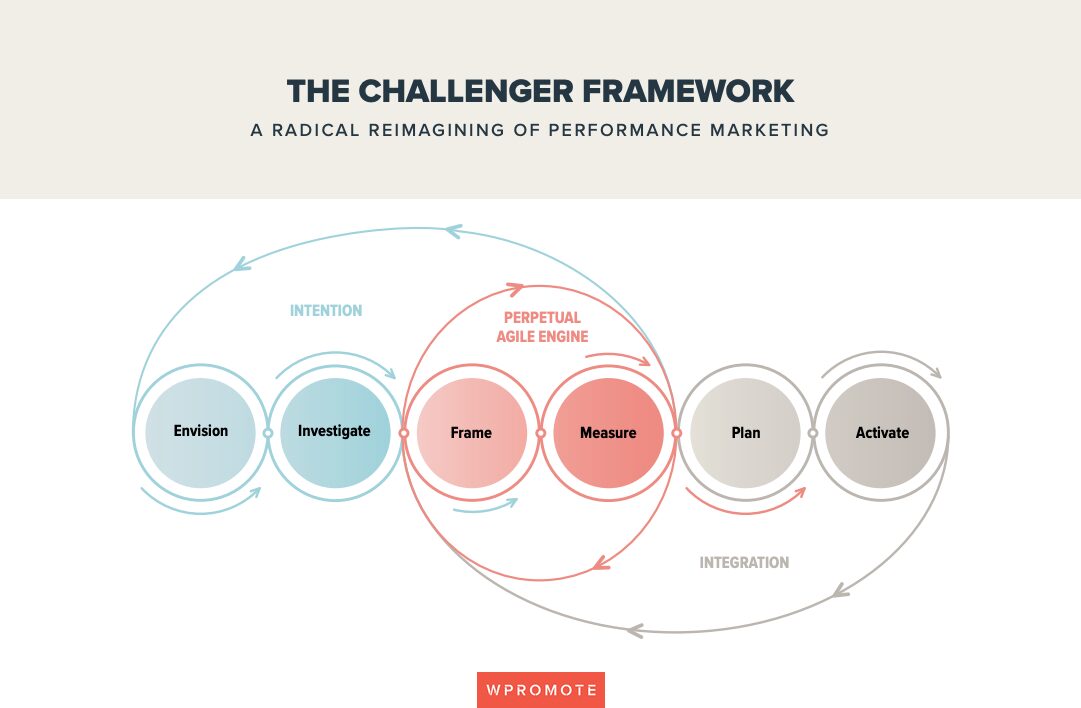Brands need to exceed customer expectations with relevant, personalized, and data-driven interactions at every stage of the customer journey, consistently across channels. Marketing leaders are charged with creating a shared vision for their teams, unsiloing decision-making, and making their strategies more agile. As an agency working with clients across every conceivable industry, we’ve gotten the chance to observe how these trends, patterns, and changes played out for a wide range of businesses. From those learnings, we built The Challenger Framework, a radical re-imagining of the traditional performance marketing approach.  So how is The Challenger Framework different from all the other marketing frameworks out there?
So how is The Challenger Framework different from all the other marketing frameworks out there?
Put a perpetual agile engine driven by real-time data and holistic strategy at the center of your marketing
Agility has emerged as the defining attribute of successful marketing in 2020, most often through digital performance channels like paid search and social. It’s now a requirement for brands to adapt to changing customer needs and capitalize on opportunities in real-time. But all of that starts with good fundamentals: understanding the customer and their behavior across every channel as they move toward a purchase decision and using this knowledge to rapidly construct and deploy relevant customer messaging, creative, and campaigns from the top of the funnel to the bottom. 
- Make sure your team is aligned on the vision for your marketing and all channels are working together toward a common goal.
- Translate what we’ve learned about the past and what we know about future trends by building scenarios and preparing for likely outcomes.
- Integrate brand and performance marketing across channels to ensure a better, more cohesive customer experience
Demolish the wall between so-called brand and performance marketing
As performance marketing has expanded in reach and scope over the past few years, it’s safe to say that it’s no longer just a type of marketing—it is marketing. Think about it like this: Every marketing plan is built with some sort of performance goal in mind, whether it’s acquisition, awareness, lead generation, etc. Instead of focusing solely on acquisition, remember that there is a very complex customer journey that leads to that decision to buy. Marketers know they need to be persuasive when it comes to marketing to customers, but you need to apply those same skills to getting buy-in from your C-suite. Make sure they understand how upper funnel initiatives require more time, are measured differently, and bolster and lift lower funnel effectiveness across the brand as a whole. But it also needs to be incorporated into your marketing strategy as a whole and held to the same standards of accountability, not left in a silo labeled “Brand Marketing.” 
Get rid of the boring brief-and-audit process and build a shared vision instead
Great marketing doesn’t start with a time-consuming/boring brief-and-audit process that just tells us what we already know. The Challenger Framework starts instead with your vision, grounded in your core business objectives (CBOs), and uses that as a guide to investigating what has worked or hasn’t worked in the past. What we need to understand is how to make that vision come to life. We’re not advocating overlooking or ignoring past performance, but instead looking specifically at what you need to understand about the past to make your marketing vision come to life. We focus on the future to set our intentions: what are we trying to achieve together? 
- The successful version: This might be very close or the same as the original CBO. Think of it as the baseline version of success: what does your marketing need to do to check the necessary boxes?
- The moonshot version: This is the Challenger sweet spot. Ask yourself how the CBO might change if your team, resources, and creativity were truly stretched: what can you picture that’s possible but would represent a serious challenge to accomplish? What has to happen that’s different from the satisfactory version to get there?
- The roofshot version: What would the vision for marketing look like if there were no obstacles and no limits? What is the ultimate version of marketing for your business?
Build innovation into your marketing through rigorous testing and calculated risk-taking
Digital marketing is always changing and re-defining itself. In a very real way, innovation is the life force of digital marketing, and the best brands know they need to adapt or die. That’s why, from the moment of activation, you need to be testing: taking calculated risks and gathering empirical data from your campaigns that open the door to exponential growth and future success. At Wpromote, constant testing is in our DNA. All of our clients have access to something we call Challenger Labs, which is dedicated to large-scale testing. Whether that’s a new campaign type, an opportunity for automation, or innovative creative, we have defined a rigorous testing methodology. We don’t think of our clients as Challengers because it’s cool (full disclosure: we think it’s pretty cool), we call them Challengers because they are fearless when it comes to getting ahead of the marketing curve.
Unlock the magical 1+1=3 equation with a radical new marketing approach
It’s clear that media consumption habits have changed, which makes right now an especially opportune time for marketers to reimagine and redefine traditional performance marketing methods. Built to embody the three essential attributes of successful marketing—agility, intentionality, and holistic integration—The Challenger Framework is a powerful tool that can help you find the solution to exponential growth driven by marketing. It’s time to make the change.





